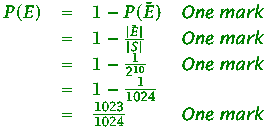| (a) |
For each of the following sets, determine whether 2 is an element of that set. (i){x |x is an integer greater than 1 } yes (ii){x |x is the square of an integer } no (iii){2, {2} } yes (iv){ {2}, { {2} } } no (v){ {2}, {2, {2} } } no (vi){ { {2 } } } no
|
[3] |
| (b) |
The matrices A and B are given by
(i)Calculate
Award one mark for correct multiplication of matrices and one for correctly transposing the matrix. (ii)Calculate Either note that
|
[4] |
| (c) |
Let p and q be the propositions
p
p
~p
(p V
q )
q
|
[5] |
| (d) |
A sequence of 10 bits is randomly generated. What is the probability that at least one of these bits is 0? Let E be the event that at least one of the 10 bits is 0.Then ¯E is the event that all the bits are 1s.Since the sample space S is the set of all bit strings of length 10, it follows that
|
[4] |
| (e) |
Use mathematical induction to prove that
whenever n is a nonnegative integer. Let P (m )be
the statement
|
[6] |
| (f) |
Let A be the set {1 ,2 ,3 ,4 }. Which ordered pairs are in the relation
R ={(1 ,1 ),(1 ,2 ),(1 ,3 ),(1 ,4 ),(2 ,2 ),(2 ,4 ),(3 ,3 ),(4 ,4 )}Two marks. Subtract one mark for each mistake up to a maximum of two.
|
[2] |
| (g) |
How many ways are there to choose 6 items from 10 distinct items when (i)the items in the choices are ordered
and repetition is not allowed?
(ii)the items in the choices are ordered
and repetition is allowed?
(iii)the items in the choices are unordered
and repetition is not allowed?
For each part award one mark for the correct formula and one mark for the correct answer. |
[6] |




